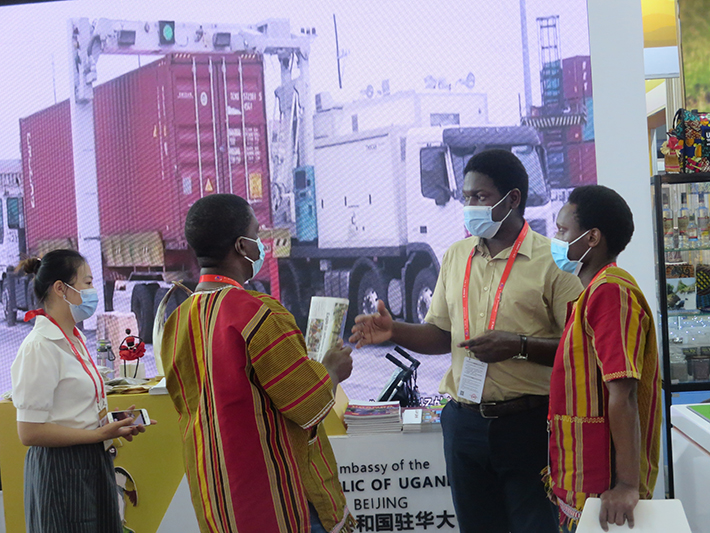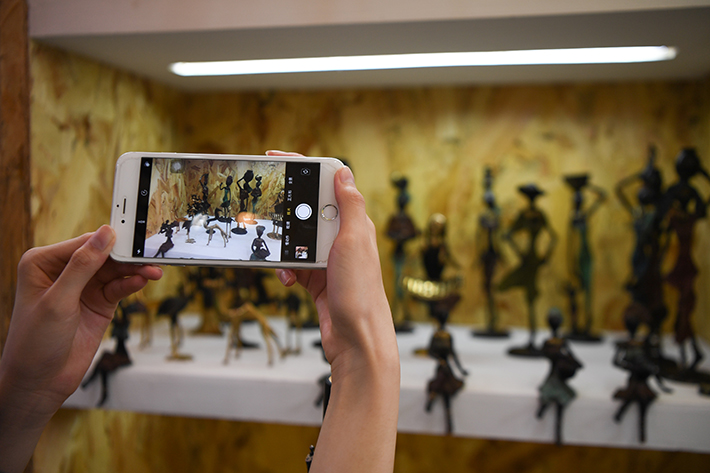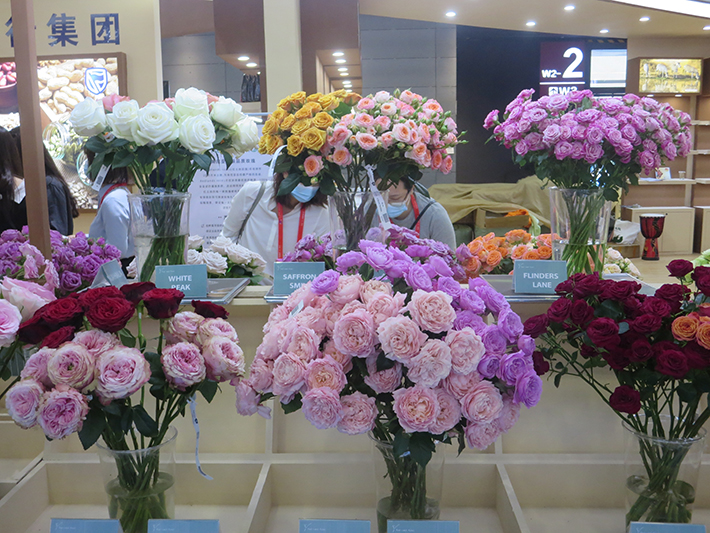|
||||||||||
| Home Nation World Business Opinion Lifestyle ChinAfrica Multimedia Columnists Documents Special Reports |
|
||||||||||
| Home Nation World Business Opinion Lifestyle ChinAfrica Multimedia Columnists Documents Special Reports |
| Current Cover Story |
| A Platform of Opportunities |
| The China-Africa Economic and Trade Expo facilitates economic exchanges |
| By Ge Lijun | VOL. 15 July 2023 ·2023-06-25 |

Ugandans take part in the second CAETE in Changsha, Hunan Province, on 27 September 2021 (GE LIJUN)
Dosso Mefah Allioune, founder of the international trading company Domali in Côte d’Ivoire, clearly understands the importance of effectively promoting African products in the Chinese market. He told ChinAfrica that he will be taking part in the China-Africa Economic and Trade Expo (CAETE) for the second time. Allioune is delighted that “more Africans will be present at the expo.”
The third edition of CAETE will be held from 29 June to 2 July in Changsha, Hunan Province, this year. It is a major meeting held every two years that all Chinese and African stakeholders look forward to.
It is an initiative proposed by Chinese President Xi Jinping at the Beijing Summit of the Forum on China-Africa Cooperation held in 2018. CAETE has now become a window showing the trend of China-Africa trade. This year’s expo will have some new features and highlights that were not present in the first two editions.
An expanded platform
At a press conference held on 13 June, the Hunan provincial government presented a preview of the third edition of CAETE. With the theme Common Development for a Shared Future, the expo has invited eight African countries as guests of honour, namely Benin, the Democratic Republic of the Congo, Madagascar, Malawi, Morocco, Mozambique, Nigeria and Zambia. So far, 53 African countries and eight international organisations have registered to take part in the event.
The total surface area of the main exhibition hall will reach 100,000 square metres, an increase of around 30,000 square metres compared to the second edition. There will be more products on show. For the first time, an exhibition area will be devoted to the high-quality achievements of the joint construction of the Belt and Road Initiative (BRI) between China and African countries, offering a comprehensive presentation of the new results of China-Africa economic and trade cooperation in the new era. For the first time, there will also be an exhibition showcasing the achievements of Chinese and African women in innovation and entrepreneurship.
The exhibition hall of African companies and organisations will bring together products from different African countries, such as essential oils from Madagascar, precious stones from Zambia, coffee from Ethiopia, wood carvings from Zimbabwe, flowers from Kenya, wine from South Africa, chillies from Rwanda, shea oil from Ghana, cosmetics from Senegal, and so on. Around 300 African companies will be present at the exhibition.
The first-ever China-Africa Trade Index will be published at the expo. As part of a digital and scientific evaluation system, it will provide a barometer for Sino-African economic and trade cooperation for business players. A report on Sino-African economic and trade relations will also be published on an ongoing basis, highlighting the new progress made in recent years. In addition, more than 40 events of all types will be organised. For the first time in the expo’s history, ministries and central institutions will be organising high-level events covering various areas of cooperation such as infrastructure, health, food, youth and women.
During the expo, new cooperation projects, agreements and achievements will be announced and presented to inject new momentum into China-Africa cooperation and show the world the new strength of this cooperation. At present, 156 cooperation projects with a total value of over $10 billion will be signed during the expo. In addition, about 20 achievements will be released, such as the report on the use of the Chinese currency renminbi in Africa, typical cases of Chinese companies fulfilling their social responsibilities in Africa, etc.

A visitor takes photos in front of Malian art objects during the first CAETE in Changsha, Hunan Province, on 28 June 2019 (XINHUA)
Fruitful outcomes
The first two editions of CAETE were organised in 2019 and 2021, both in Changsha. The two expos attracted participants from 53 African countries, more than 10 international organisations, 31 Chinese provinces and municipalities, 29 ministries and central institutions, more than 200 state-owned enterprises and subsidiaries, as well as thousands of Chinese and African enterprises, trade associations and financial institutions. A total of 216 cooperation projects or agreements worth $43.02 billion have been signed. The platform has played an active role in promoting the high-quality development of economic and trade cooperation between the two sides.
Hunan Province has benefitted from this momentum. Data from Changsha Customs District show that trade between Hunan and Africa reached a record high in 2022, amounting to 55.66 billion yuan ($7.8 billion), up 42.8 percent over the previous year, ranking Hunan first in China’s central region and eighth nationally in terms of trade with African countries. The volume of trade between Hunan and Africa in the first four months of this year reached 22.04 billion yuan ($3.1 billion), an increase of 90.4 percent over the same period last year.
According to the journal West Asia and Africa, CAETE has contributed to the entry of more and more African agricultural products into the Chinese market over the past three years, effectively improving the structure of China-Africa trade. At present, Hunan is using African Non-Resource Product Distribution, Trading and Processing Centre to promote the construction and operation of six industrial import chains from Africa, including coffee, nuts, dried chillies, sesame seeds, peanuts and wood products.
On the other hand, CAETE has reduced the institutional costs of China-Africa trade and improved the level of bilateral trade facilitation. In September 2021, the Department of Commerce of Hunan Province and the International Trade Centre jointly launched the partnership for enhancing export capacity of Africa to China to solve the problems related to the import declaration of African products and non-compliance with Chinese production standards, and achieve the goal of the continuous expansion of China importing African non-resource products. According to the needs of enterprises and markets, Hunan Customs focused on 21 types of high-quality products from eight African countries, giving priority to African agricultural products intending to sign contracts at CAETE, especially those with high added value, in the process of standardised inspection and quarantine.
Previously, China imported Tanzanian cashew nuts, which had to pass through traders in Eastern Europe before being processed in Vietnam and then sent to China. Now, thanks to the direct purchasing channels, transport time can be cut by a month and a half, and the cashews can be processed on automatic production lines in China, reducing costs by around 20 percent.
“In July 2019, after the first CAETE, Chinese companies entered the agricultural products market in Africa, set up processing plants and shipped African sesame, soybean and other agricultural products to China after preliminary processing,” said Zeng Chanjuan, general manager of Houchang International Trading Co. This company currently holds the only right to buy cashew nuts directly from Tanzania. Through the channel offered by CAETE, the company plans to work with downstream companies to build a complete cashew industrial chain, from direct purchase to final production in Hunan Province.
Benin’s Ambassador to China Simon Pierre Adovelande said in an interview that CAETE had produced fruitful results. He is convinced that the third edition will continue to strengthen China-Africa exchanges, broaden the economic and commercial scope and enable more African businesses to benefit from the opportunities offered by China’s open market.

Kenyan flowers on display at the second CAETE in Changsha, Hunan Province, on 27 September 2021 (GE LIJUN)
Fruitful exchanges
Figures released at the press conference held on 13 June by the State Council Information Office on the third CAETE, the scale of economic and trade cooperation between China and Africa continued to expand in the past decade. The total volume of China-Africa trade has increased to over $2 trillion, with China remaining Africa’s largest trading partner. Chinese enterprises have signed contracts for engineering projects in Africa worth more than $700 billion. China’s cumulative direct investment stock in Africa has exceeded $30 billion, making it the fourth-largest source of investment in Africa.
According to the latest statistics from the General Administration of Customs of China, the volume of trade between China and Africa reached $282 billion in 2022, representing a year-on-year growth of 11.1 percent. Exports of African agricultural products to China have enjoyed positive growth for six consecutive years, while China has maintained its position as the leading trading partner of Africa for 14 consecutive years. Liu Yuxi, special representative of the Chinese government on African affairs, told a think tanks forum on 30 May that the China-Africa relationship has entered a fast lane of all-round, high-quality development, and that the pragmatic and mutually beneficial cooperation between China and Africa in the new era has continued to bear fruit.
On 15 May, a matchmaking meeting for economic and commercial exchanges between the city of Shaoyang, Hunan Province, and Ghana was held in Accra, capital of Ghana. Michael Okyere Barfi, Ghana’s deputy minister for trade and industry, said that Africa is a huge market with a population of 1.2 billion. With the establishment of the African Continental Free Trade Area, the African market is undoubtedly becoming very attractive to Chinese investors. In his view, improving manufacturing is the key to promoting industrialisation in Africa. In this area, there are vast opportunities for cooperation between Chinese and Ghanaian companies.
| About Us | Contact Us | Advertise with Us | Subscribe |
| Copyright Beijing Review All rights reserved 京ICP备08005356号-5 京公网安备110102005860号 |